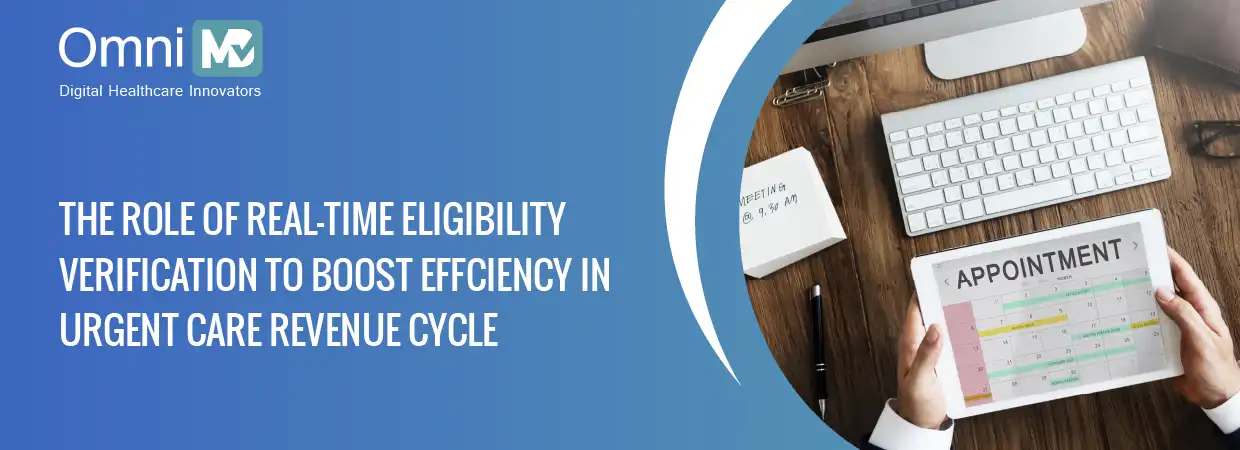The Role of Real-Time Eligibility Verification to Boost Efficiency in Urgent Care Revenue Cycle
Is your urgent care facility facing issues in managing the revenue cycle?
Or
Are insurance claims processed slowly and accurately?
In such a scenario, real-time eligibility verification (RTE) is the solution. The efficiency of urgent care centres is crucial not only for patient care but also for financial operations. Hence, real-time eligibility verification can transform the financial process, allowing urgent care facilities to streamline operations, reduce denials, and ultimately increase profitability.
According to HFMA, errors in insurance eligibility verification account for over 75% of claim rejections and denials by payers. Moreover, refiling these rejected claims can lead to an annual loss of $50,000 to $250,000 in net revenue for every 1% of claims rejected.
Further, we will delve into how real-time eligibility verification helps improve the urgent care revenue cycle effectively.
What is Real-Time Eligibility Verification (RTE)?
Real-time eligibility Verification tools are software that allows healthcare providers and facilities to quickly verify a patient’s insurance coverage and eligibility in real-time. These tools interface with various insurance payers to confirm a patient’s coverage status, copays, deductibles, and other relevant insurance information before or during the patient’s visit.
Traditional Eligibility Verification vs. Real-time Verification
Traditional Eligibility Verification
The traditional method of eligibility verification risks impeding the standard Accounts Receivable (A/R) cycle and threatening diminishing monthly revenues. Verifying insurance eligibility through manual payer searches or labor-intensive phone calls not only proves time-consuming but also hampers patients’ prompt and efficient access to necessary treatments.
For instance, a patient visits a clinic, and the staff submits an insurance check request via fax. The clinic has to wait until the insurance company responds, which could take days. This delay may affect the billing cycle and patient experience.
In traditional eligibility verification, the absence of an efficient verification method often leads to challenges in contacting payers and delineating payer/patient payment responsibilities. Hence, traditional eligibility frequently results in several errors during the claims submission.
Real-Time Eligibility Verification
A real-time verification process accessible through a single platform proves more efficient. By facilitating streamlined communication with payers, real-time verification offers fast and instant eligibility responses, enabling teams to ascertain insurance coverage within seconds rather than hours or days.
Leveraging a real-time insurance eligibility verification tool empowers healthcare providers with a highly efficient workflow that enables seamless communication with a wide array of insurance payers.
Real-time eligibility queries result in instant, user-friendly outputs with essential copay and deductible details. These services empower providers to determine patient eligibility and understand their insurance coverage specifics before the patient’s visit, eliminating any waiting period. Providers no longer need to use cumbersome computerized IVR systems to verify a patient’s eligibility benefits. Hence, it saves time for both providers and payers while improving overall revenue collections.
A good example is if a patient visits a hospital, and the staff uses real-time eligibility verification. Within seconds, they receive confirmation that the patient’s insurance is valid and details about coverage and copays, allowing for quicker treatment decisions and faster payment processing.
Importance of Real-Time Eligibility Verification in Urgent Care
Urgent care facilities operate in a fast-paced environment where every minute is important. Delays in verifying a patient’s insurance coverage can lead to inaccurate billing, denied claims, and lost revenue. Real-time eligibility verification addresses these issues by allowing staff to verify a patient’s insurance coverage instantly, which ensures that patients are appropriately billed for their visits and claims are submitted with the correct information the first time. It reduces the possibility of claim rejections and improves the overall revenue cycle management (RCM) process.
How Real-Time Eligibility Verification Works in Urgent Care
Real-time eligibility verification integrates directly into an urgent care’s existing electronic health record (EHR) or practice management system (PMS). This system communicates with payer databases to confirm a patient’s eligibility for coverage at the time of service. The system checks various aspects of the patient’s insurance policy, including:
- Deductibles and out-of-pocket limits
- Copays and co-insurance amounts
- Policy exclusions or limitations
- Effective dates of coverage
By quickly providing the above-mentioned information, real-time eligibility verification empowers staff to address coverage issues before services are offered. It reduces the probability of uncompensated care, improves patient satisfaction, ensures that claims are submitted correctly, and minimizes payment delays.
Imagine a patient entering an urgent care center with a severe health condition. The clinic needs to confirm the patient’s insurance eligibility before proceeding with treatment to prevent billing issues later.
With Real-Time Eligibility Verification, the clinic’s front desk staff quickly inputs the patient’s insurance details into the system. The system confirms the patient’s coverage, copay amounts, and deductible status within seconds. Quick verification allows the staff to inform the patient of out-of-pocket expenses. Thereafter, the patient can proceed with treatment, and the clinic can prevent potential billing complications or claim rejections later.
This process significantly reduces waiting times, enhances the patient experience, and ensures the clinic can verify correct payers nationwide, which streamlines the entire administrative workflow.
Top Benefits of Implementing Real-Time Eligibility Verification
Implementing real-time eligibility verification in urgent care offers several advantages as it enhances both patient experience and operational efficiency:
Reduced Claim Denials
One of the most critical benefits of real-time eligibility verification is the substantial reduction in claim denials. Incorrect or outdated insurance information is one of the leading causes of claim rejections. With real-time verification, urgent care facilities can ensure that the insurance information on file is accurate and current before a claim is submitted. This proactive approach significantly reduces the chances of denials and allows facilities to be paid more quickly for their services.
Enhanced Patient Experience
Urgent care patients require fast and efficient service. Real-time eligibility verification allows staff to accurately estimate patient responsibility for copays and deductibles during service. By being transparent with patients upfront, urgent care centers can prevent unexpected charges that often arise from inaccurate insurance information. This improves patient trust and increases the likelihood of repeat visits.
Faster Payments and Improved Cash Flow
Faster eligibility verification means quicker claim submission, which leads to faster reimbursements. When claims are submitted with accurate insurance data, they are less likely to be delayed or rejected. This leads to a shorter accounts receivable cycle and better cash flow for the urgent care facility. In addition, real-time verification enables staff to collect copays and deductibles at the time of service, reducing the requirement for follow-up billing and increasing the chances of full payment.
Improved Staff Efficiency
Manually verifying patient insurance can be time-consuming and error-prone. By automating the verification process, real-time eligibility tools free up staff to focus on more important tasks, such as patient care and administrative duties. With fewer errors to correct and less time spent on follow-up billing, urgent care facilities can operate more efficiently and effectively.
Reduced Administrative Costs
Real-time eligibility verification reduces administrative costs associated with re-submitting denied claims and following up on unpaid patient balances. By catching insurance coverage issues before services are provided, urgent care centers can reduce the time and resources spent on claim appeals and patient collections.
Key Considerations for Implementing Real-Time Eligibility Verification
Before implementing real-time eligibility verification, urgent care centers should consider several factors to ensure a smooth and successful transition.
Integration with Existing Systems
One of the most critical aspects of real-time eligibility verification is ensuring that it integrates seamlessly with the urgent care center’s existing EHR or PMS. The system should communicate effectively with insurance payers and provide real-time updates on patient coverage. Facilities should choose a solution compatible with their current technology stack to avoid needing expensive upgrades or replacements.
Training and Support
While real-time eligibility verification can significantly streamline the revenue cycle, it’s essential that staff are adequately trained on how to use the system. Ensuring that staff can troubleshoot issues and understand the nuances of different insurance policies will help reduces errors and improve overall efficiency. Also, urgent care centers should work with a vendor that provides ongoing support to address any issues that arise after implementation.
Cost vs. ROI
The cost of implementing a real-time eligibility verification system can vary depending on the size of the facility and the complexity of its existing systems. However, the long-term benefits, such as reduced denials, improved cash flow, and increased patient satisfaction, can outweigh the initial investment. Urgent care centers should carefully evaluate their return on investment (ROI) when implementing a real-time verification solution.
How Real-Time Eligibility Verification Enhances Revenue Cycle Management
Real-time eligibility verification plays a crucial role in improving revenue cycle management (RCM) for healthcare providers:
Accurate Billing from the Start
By verifying insurance eligibility in real-time, urgent care centers can prevent billing errors that lead to delayed payments and denied claims. This ensures that patients are billed correctly the first time, reducing the need for follow-up billing and collections. Accurate billing from the start also improves patient satisfaction, as patients are less prone to receive unnecessary, costly bills for services that their insurance does not cover.
Minimizing Bad Debt and Uncompensated Care
When urgent care centers provide services to patients without verifying their insurance coverage, they risk not being paid for those services. Real-time eligibility verification reduces this risk by ensuring that coverage is verified before care is provided. It also reduces the amount of bad debt and uncompensated care that urgent care centers have to absorb, which improves overall financial stability.
Streamlined Collections Process
Real-time eligibility verification allows urgent care centers to collect patient copays and deductibles at the time of service, reducing the need for post-service billing and collections. It also helps improve the efficiency of the collections process and ensures that urgent care centers receive payment more quickly.
The Way Forward
Implementing real-time eligibility verification is a game changer for urgent care centers looking to improve their revenue cycle management. Real-time verification ensures that urgent care facilities can operate more smoothly and profitably by reducing claim denials, enhancing patient satisfaction, speeding up payments, and improving staff efficiency. With the right system in place, urgent care centers can focus on what matters most, i.e., providing high-quality care to patients without worrying about the complexities of insurance verification.

All-in-One EHR Software
Streamline Your Practice with a Complete EHR Solution

 Written by Neha Singh
Written by Neha Singh
 Reviewed by Shivani Joshi
Reviewed by Shivani Joshi